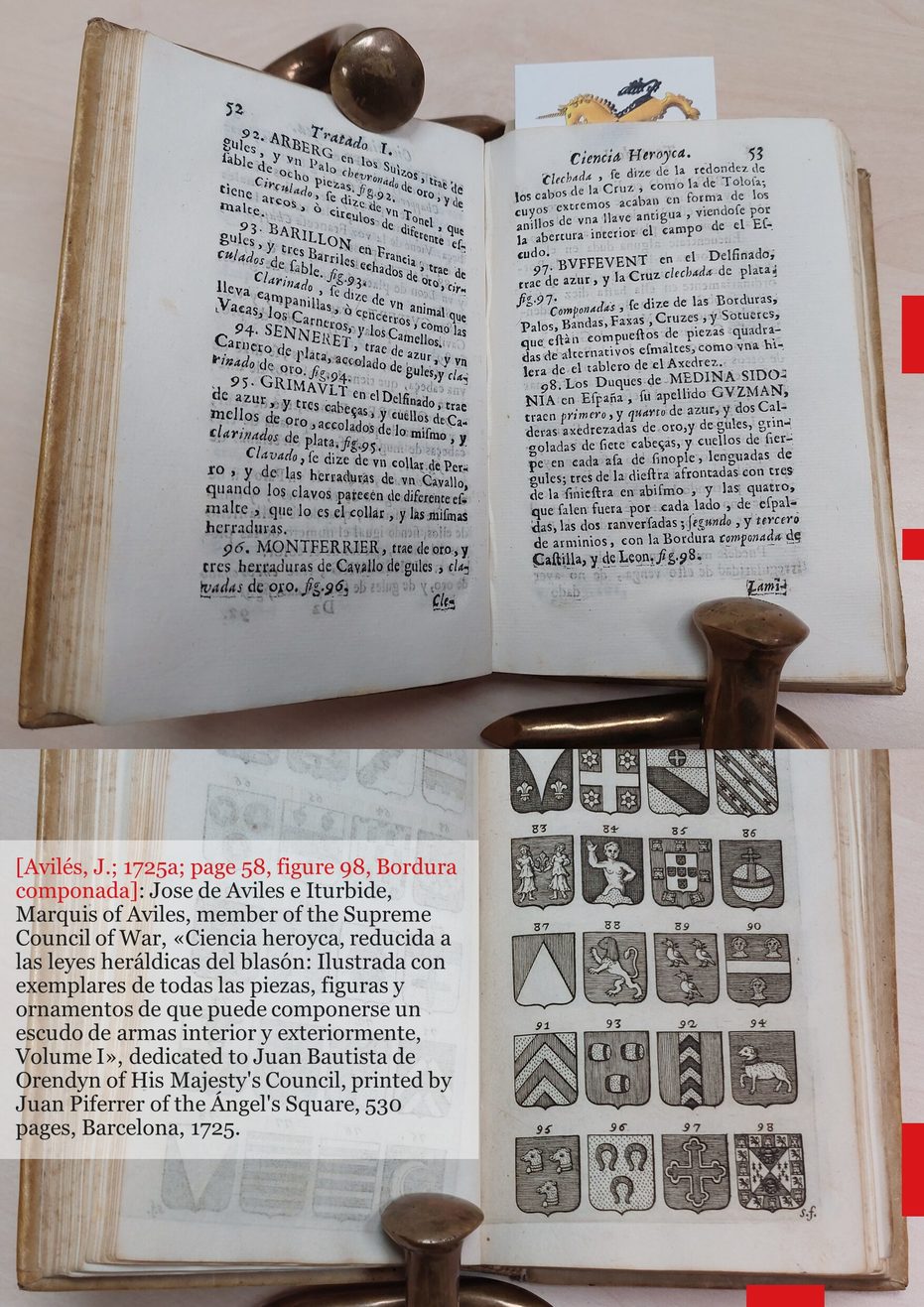
![Ver [Sevilla Gómez, A.; 2000] en referencias bibliográficas. Libro abierto, hojas de plata, filo de oro, guardas de gules, tapas de sable.](../css/Libro.Bibliografia.png)
Sevilla Gómez, A.; 2000
Antonio Sevilla Gómez, «Las paremias heroicas: la divisa, el lema y el mote», Paremia Magazine, number 9, pages 75 to 80, Madrid, 2000.
Bibliographical reference of century XX.
The author is Sevilla Gómez, Antonio.
Bibliographical reference mentioned in the following article:
External resource:
Internal resources: SevillaGomezA2000.DivisaLemaMoteGritoGuerra.pdf.


Henry II of England
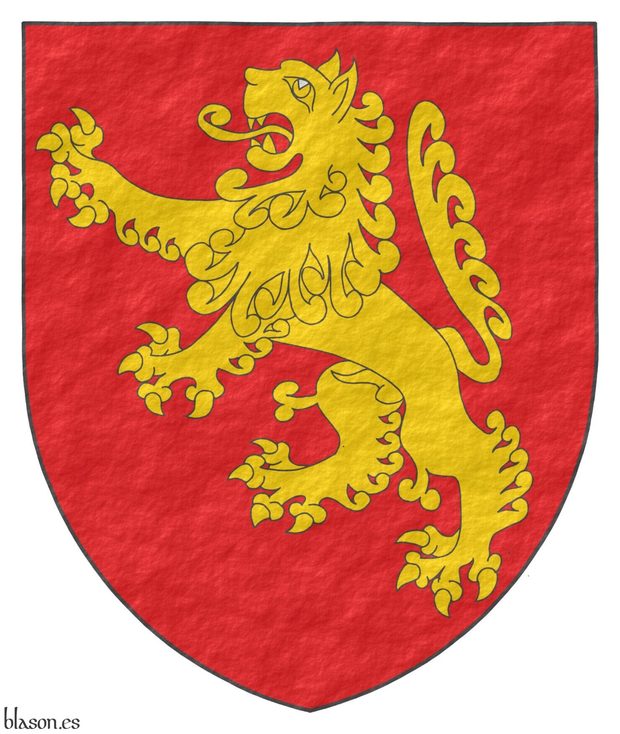
Henry II Plantagenet, King of England, Duke of Normandy, Duke of Aquitaine, Count of Anjou, Count of Maine, and Count of Nantes.
Gules, a lion rampant Or.
Escudo de gules, un león rampante de oro.
Existing arms interpreted by me as follows: the shield's shape is pointed; the field has been enamelled in flat Gules; the lion in Or has been outlined in Sable; and the whole composition has a rough texture finish.
It is believed that Henry I was the first King of England to have a coat of arms, featuring a single lion rampant, but no documentary evidence has yet been found [Rabbow, A.; 1999; paragraph 8].
[Ailes, A.; 1982; page 62] argues that Henry II may have used three different versions of his arms featuring a) a single lion rampant, b) two leopards, and c) three leopards. However, it remains unclear whether these versions were used sequentially over time or concurrently. For this interpretation, I have chosen the version with the lion rampant.
Blazon keywords: Without divisions, Gules, One, Lion, Or and Rampant.
Style keywords: Pointed, Plain tincture, Outlined in sable and Rough.
Classification: Interpreted, Coat of arms, Personal, House of Plantagenet and Kingdom of England.
Bearer: Henry II of England.


![Ver [Ailes, A.; 1982] en referencias bibliográficas. Libro abierto, hojas de plata, filo de oro, guardas de gules, tapas de sable.](../css/Libro.Bibliografia.png)
Ailes, A.; 1982
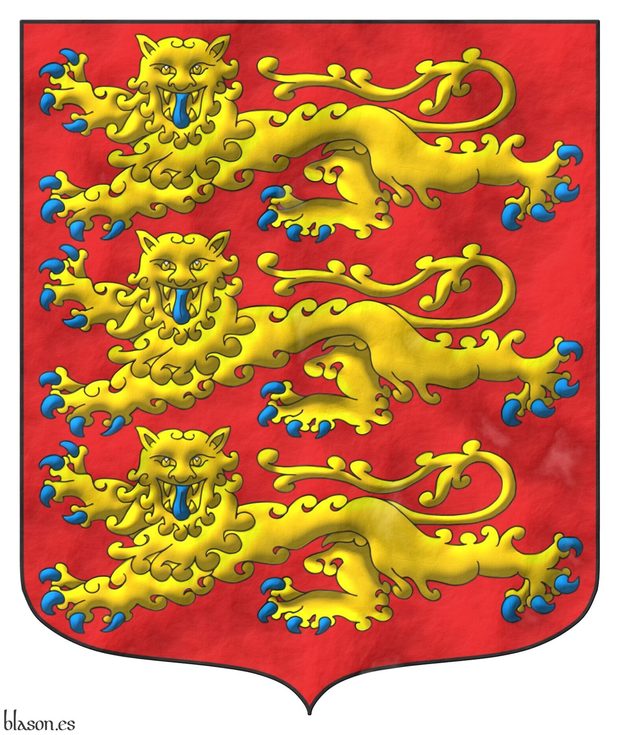
Adrian Ailes, «The Origins of the Royal Arms of England: Their Development to 1199», foreword by Rodney Dennys, includes 27 black and white illustrations, Graduate Centre for Medieval Studies, Reading University, 126 pages, ISBN 07-049077-6-3, Reading, Berkshire, 1982.
An article reviewing this book is: Brigitte Bedos Rezak, Archives nationales de Paris and Metropolitan Museum of Art, «The Origins of the Royal Arms of England, their Development to 1199 by Adrian Ailes», Speculum, volume 60, number 2, pages 373-376, Medieval Academy of America, Cambridge, Massachusetts, April of 1985.
Bibliographical reference of century XX.
Author: Ailes, Adrian.
Bibliographical reference mentioned in the following article:
External link:


![Ver [Rabbow, A.; 1999] en referencias bibliográficas. Libro abierto, hojas de plata, filo de oro, guardas de gules, tapas de sable.](../css/Libro.Bibliografia.png)
Rabbow, A.; 1999
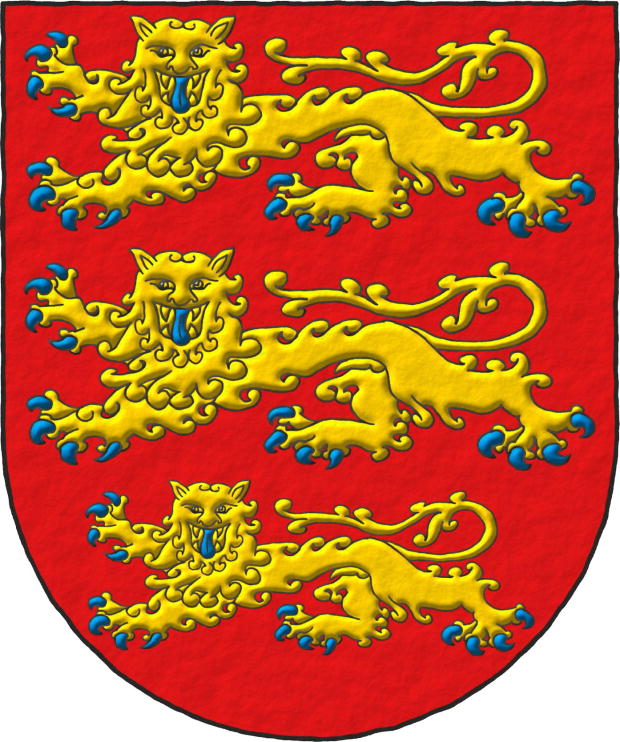
Arnold Rabbow, «The Origin of the Royal Arms of England - a European Connection», Coat of Arms, COA, An Heraldic Quarterly Magazine, número 186, The Heraldry Society, Baldock, Hertfordshire, verano de 1999.
This bibliographical reference is illustrated wit the coat of arms of the Kingdom of England interpreted by me with the with a semi-circle shape.
Bibliographical reference of century XX.
The author is Rabbow, Arnold.
The following article cites this bibliographic reference:
External resource:
Internal resources: RabbowA1999.OriginRoyalArmsEnglandEuropeanConnection.docx.


Leonor de Aquitania
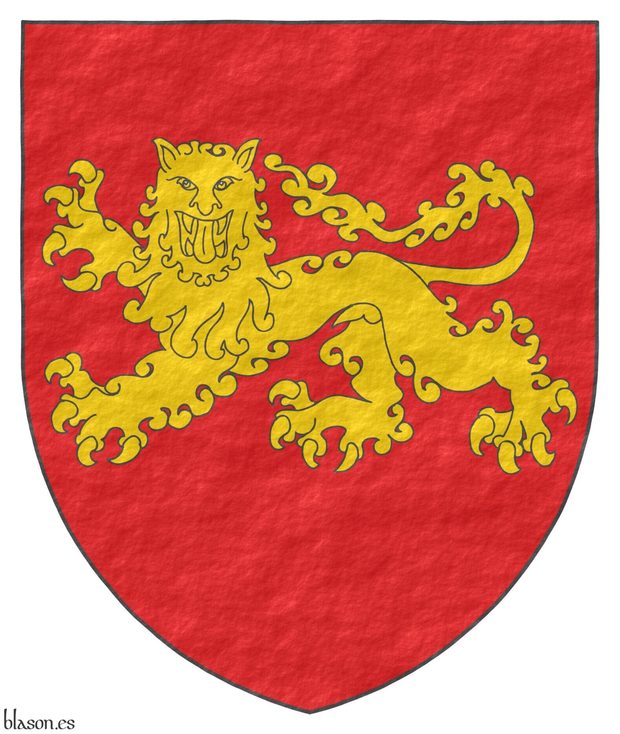
Duchess of Aquitaine, Queen Consort of France (1137-1152), and Queen Consort of England (1154-1189).
Gules, a lion passant, guardant Or.
Escudo de gules, un leopardo de oro.
Existing arms interpreted by me as follows: the escutcheon's shape is pointed; the field has been enamelled in flat Gules; the leopard in Or is outlined in Sable; and the whole composition has a rough texture finish.
I have blazoned it as a leopard, which is the term used for a lion when passant, [Avilés, J.; 1725a; pages 290 and 295] and [Avilés, J.; 1780a; pages 325 and 330] «a lion, whose natural position is rampant;... unlike the leopard, which is... always passant» and «leopards have... their heads facing forward, showing both eyes,... lions are... in profile, revealing only one eye... Their posture is never rampant, like the lion’s, but always passant;... if leopards are ever depicted rampant, they are blazoned as ‘leopard-lions’,... and likewise, lions that are passant are blazoned as ‘lion-leopards’.».
For this interpretation of Eleanor’s coat of arms, I have followed [Edward IV of England; 1461; shield 18], where a leopard Or appears, but neither armed nor langued in Azure, representing the Duchy of Aquitaine.
Blazon keywords: Without divisions, Gules, One, Leopard and Or.
Style keywords: Pointed, Plain tincture, Outlined in sable and Rough.
Classification: Interpreted, Personal, Coat of arms, Duchy of Aquitaine, Kingdom of France and Kingdom of England.
Bearer: Leonor de Aquitania.


Leonor de Aquitania y Enrique de Inglaterra
[ Gules, a lion rampant Or, ] accolé with [ Gules, a lion passant, guardant Or ].
[ Escudo de gules, un león rampante de oro, ] acolado de un [ escudo de gules, un leopardo de oro].
Existing arms interpreted by me as follows: both coat of arms are rotated ±30o; their shapes are pointed; the field of each coat of arms has been enamelled in flat Gules; the lion and the leopard in Or are outlined in Sable; and the whole composition of both arms has a rough texture finish.
Examples of accolated coat of arms (written as «accolé» in the 18th century) can be seen in [Avilés, J.; 1780a; pages 24 and 25 and plate 1: figures 1 and 2].
Blazon keywords: Without divisions, Gules, One, Lion, Or, Rampant and Leopard.
Style keywords: Pointed, Plain tincture, Outlined in sable, Tilted shield and Metal beaten.
Classification: Interpreted, Personal, Accolé arms, Duchy of Aquitaine, Kingdom of France and Kingdom of England.
Bearer: Leonor de Aquitania.


Leonor de Aquitania, escudo redondeado
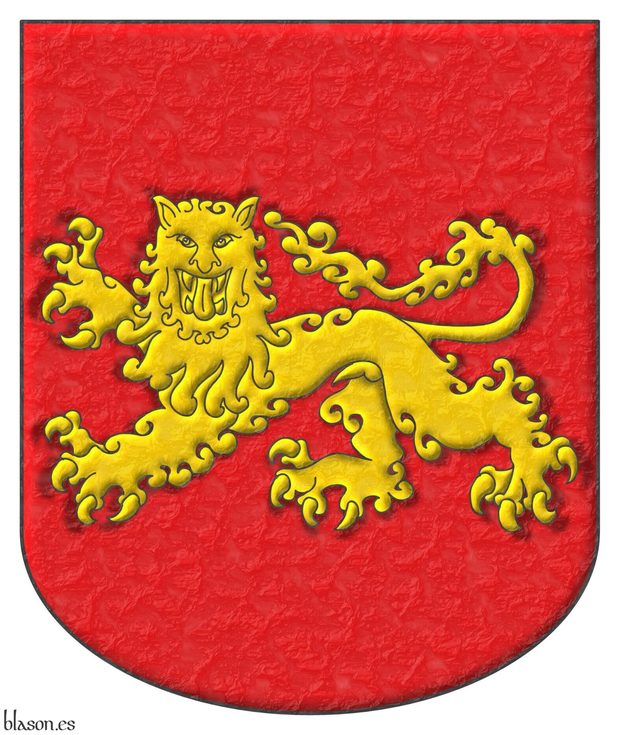
Gules, a lion passant, guardant Or.
Escudo de gules, un leopardo de oro.
Arms interpreted by me with: the shape of the coat of arms rounded; the field illuminated in Gules; the leopard illuminated in Or, outlined in Sable, and shaded; and the whole composition finished with a marble texture.
A description of the leopard in heraldry can be found in [Medél, R.; 1846; page 38].
Blazon keywords: Without divisions, Gules, One, Leopard and Or.
Style keywords: Rounded, Illuminated, Outlined in sable and Marmoreal.
Classification: Interpreted, Personal, Coat of arms, Duchy of Aquitaine, Kingdom of France and Kingdom of England.
Bearer: Leonor de Aquitania.


![Ver [Avilés, J.; 1725a] en referencias bibliográficas. Libro abierto, hojas de plata, filo de oro, guardas de gules, tapas de sable.](../css/Libro.Bibliografia.png)
Avilés, J.; 1725a
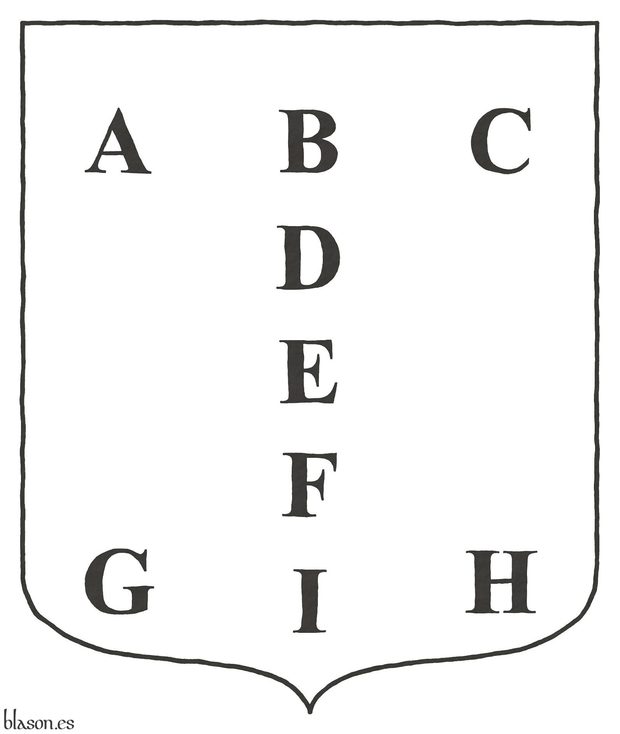
José de Avilés e Iturbide, Marquis of Aviles, member of the Supreme Council of War, «Ciencia heroyca, reducida a las leyes heráldicas del blasón: Ilustrada con exemplares de todas las piezas, figuras y ornamentos de que puede componerse un escudo de armas interior y exteriormente, Volume I», dedicated to Juan Bautista de Orendyn of His Majesty's Council, printed by Juan Piferrer of the Ángel's Square, 530 pages, Barcelona, 1725.
I also usually consult Volume I of the edition [Avilés, J.; 1780a].
Contents of Volume One
- Cover page.
- Dedication.
- Censor's review from 1724.
- Approval.
- To the reader.
- Epigram.
- Summary of privileges.
- Summary of the price.
- Plate index.
- Warnings.
- Errata sheet for each of the treatises.
- Additions.
- Table of the treatises.
- 378 pages for its 4 treatises: Treatise I with 3 chapters and a dictionary, Treatise II with 3 chapters, Treatise III with 3 chapters, and Treatise IV with 4 chapters.
- 34 plates with more than 650 coats of arms arranged at the end of each treatise, as follows: Plates 1 to 16 at the end of Treatise I, Plates 17 to 19 at the end of Treatise II, Plate 20 at the end of Treatise III, and Plates 21 to 34 at the end of Treatise IV.
- Index of terms, words, and figures specific to blazonry.
- Index of cities, titles, and families with coats of arms blazoned in this second volume.
Bordure compony
Bibliographical reference of century XVIII.
Classification: In black and white and Castilian language.
Author: Avilés e Iturbide, José.
The following articles cite this bibliographic reference:
- Adrian V
- Baudry in France
- Bourgeois, lineage of Burgundy
- Criteria used by its title
- Dancetty, ratio, points and blazon
- Edmund Plantagenet
- Ferdinand II of Leon
- Flanched, schemaat one-fifth
- Innocent IV
- Leonor de Aquitania
- Navarre
- Nhf, Norsk Heraldisk Forening
- Oschoven of the Rhin
- Pile issuant from the base in the Dictionary of the Spanish Language
- Richard I of England
External resources:
- Valencian Digital Library, records for the Volumes I and II.
- Valencian Digital Library, content of Volume I.
Internal resources: AvilesJ1725.Tomo.I.pdf.

Continue with: Edward IV of England; 1461.
-
Language
-
Categories of heraldry
-
Divisions of the field
- Without divisions
- Party per pale
- Party per fess
- Party per bend
- Party per bend sinister
- Tierce
- Tierce sinister
- Tierced per fess
- Tierced per bend
- Tierced pallwise inverted
- Quarterly
- Quarterly per saltire
- Gyronny
- Party per fess, the chief per pale
- Party per pale, the sinister per fess
- Party per fess, the base per pale
- Party per pale, the dexter per fess
- Chapé
- Chaussé
- Party per chevron
- Enté en point
- Flanched
-
Metals
-
Colours
-
Furs
-
Other tinctures
-
Ordinaries and sub-ordinaries
-
Diminutives of the ordinaries
-
Other charges
-
Charges from Nature
Water, Eagle, Bald eagle, Eagle claw, Dorsal fin, Tail fin, Two hands clasped, Lark, Tree, Trunk, Rainbow, Atom, Barbel, Acorn, Bighorn sheep, Arm, Owl, Vulture, Horse, Head, Goat, Camellia, Thistle, Merino ram, Kapok tree, Stag, Doe, Crescent, Increscent, Chrysanthemum, Tail, Tail addorsed, Ermine spot, Hummingbird, Snowflake, Heart, Roe deer, Neck, Roe deers' attires, Raven, Dolphin, Diamond, Tooth, Elephant, Emerald, Starling, Mullet, Mullet of four points, Star of David, Estoile, Male figure, Fleur de lis, Flower, Cornflower, Dogwood flower, Lotus flower, Hop cone, Bluebonnet, Puffin, Ash, Rooster, Claw, Talon, Goose, Heron, Seagull, Pomegranate, Sunflower, Swallow-tail, Falcon, Leaf, Boar, Goldfinch, Laurel, Barn owl, Lion, Lioness, Lion passant, Leopard, Lion rampant guardant, Lynx, Lily, Madonna lily, Flame, Wolf, She-wolf, Parrot, Moon, Hand, Apple, Apple tree, Martlet, Wing, Two wings in vol, Covert, Blackbird, Mount, Trimount, Fly, Wrist, Elm, Olive tree, Orbital, Bear, Palm frond, Palm tree, Dove, Poplar leaf, Panther, Jaguar, Vine, Paw, Forepaw, Foot (palmiped), Foreleg, Peacock, Chest, Pelican, Pelican in her piety, Dog, Brach hound, Warren hound, Fish, Hoof, Beak, Quill, Cinquefoil, Quetzal, Branch, Sprig, Frog, Shamrock, Caboshed, Oak, Holm oak, Rose, Double rose, Savage, Serpent, Plough of Ursa Major, Sun, Sun in splendour, Ray of the sun, Lightning flash, Stem, Badger, Tyger, Linden, Wheat, Wheat spike, Bull, Tulip, Udder, Escallop and Fox.
-
Artificial charges
Halberd, Plough share, Ace of spades, Anchor, Cyclamor, Torch, Bow, Arch, Harp, Non-classic artifact, Winnowing fan, Crozier, Conductor's baton, Pair of scales, Ship, Norman ship, Beret, Grenade, Ecclesiastical cap, Arm vambraced, Knight, Chain, Covered cup, Monstrance, Bell, Bell tower, Cannon dismounted, Carbuncle, Castle, Ribbon, Clarion, Nail, Cord, Dagger, Key ward, Turret, With a turret, Armillary sphere, Sword, Federschwert, Sabre, Parchment, Scroll, Arrow, Club, Garb, Sheaf of tobacco, Scythe, Gauntlet, Axe, Buckle, Galician granary, Polish winged hussar, Church, Oil lamp, Spear, Spear's head, Fleam, Letter, Book, Open book, Closed book, Bookmark, Page, Line, Lantern, Key, Four crescents joined millsailwise, Hammer, Menorah, Mortar, Pestle, Number, Knot, Celtic Trinity knot, Water-bouget, Comb, Piano, Millstone, Millrind, Millwheel, Clay pot, Bridge, Cuffed, Hourglass, Chess rooks, Compass rose, Rosette of acanthus leaves, Mullet of six points pierced, Broken, Portcullis, Wheel, Wagon-wheel, Symbol, Sackbut, Drum, Geometric solid, Tetrahedron, Tower, Trident, Trumpet, Double vajra and Anvil.
-
Immaterial charges
Angel, Archangel, Heart enflamed, Sacred Heart of Jesus, Paschal lamb, Dragon, Wyvern, Phoenix, Garuda, Griffin, Sea-griffin, Winged hand, Our Lady of Mercy, Pegasus, Saint George, Mermaid, Trinity, Triton, Golden fleece, Unicorn and Ouroboros.
-
External elements
-
Heraldic creations
-
References
-
Formats
-
Keywords on this page
Pointed, Armed, Azure, Bibliography, House of Plantagenet, House of York, Quarterly, Outlined in sable, Duchy of Aquitaine, In black and white, In pale, Coat of arms, Accolé arms, Schema, Fleur de lis, Personal, Gules, Henry II of England, Illuminated, Interpreted, Langued, Castilian language, Leonor de Aquitania, Leopard, Lion, Marmoreal, Metal beaten, Ordered, Or, Without divisions, Rampant, Rounded, Kingdom of France, Kingdom of England, Tilted shield, Rough, Century XV, Century XVIII, Century XX, Plain tincture, Three and One.
![Leonor de Aquitania y Enrique de Inglaterra [ Gules, a lion rampant Or, ] accolé with [ Gules, a lion passant, guardant Or ].](../escudo_armas/LeonorA.22.EnriqueII.jpg)
